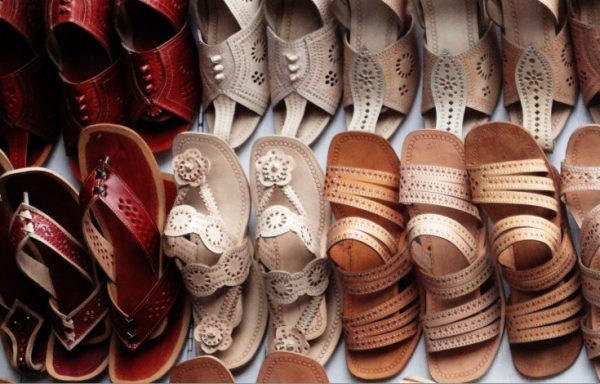The picturesque town of Chamba named after the devout royal princess of Bharmour, Champavati is situated on the banks of the river Ravi at an elevation of about 926 feet. Historians say that Chamba was known as Airavati in the ancient times. There are very few places in the world that can rival its stunning natural beauty with the Dhauladhar range, Pir Panjal and Zanskar range of the Himalayas enveloping Chamba giving it an appearance of a village fortress.
The origin of the famed leather embroidered Chamba chappals can be traced back to 1808 C.E. It is said that the princess of Katoch, rulers of Kangra was unhappy with her upcoming nuptials with Raja Charhat Singh of Chamba as she felt that the people of Chamba wore crude looking shoes. Therefore, a cobbler from Panj Baria village of Nurpur was sent as a part of her dowry to make beautifully embroidered leather footwear for her.
It is said that before the princess arrived in Chamba, the people of Chamba used to wear shoes made of grass. Gradually, with her influence and patronage, leather embroidery gained popularity in Chamba.
The art of leather embroidery reflected the cultural traditions of the people. Mango and mango leaf and thereby the mango motif provided the inspiration for the different variations of embroidery and in turn designs of Chamba chappals. There are two types of Chamba chappals namely the plain made by men and the embroidered made by women. These handcrafted leather chappals are extremely comfortable and come in different colours. Some of the most popular designs are based on baloo (nath), snake (looks like a hood of a snake and V-shaped), fish (created like a fish swimming with the eyes, nose and fins decorated) and chandni (based on a full moon in the sky).
The materials used to create these exquisite footwears are sheep and goat skin, fancy leather, suede leather, locally made sole leather, chrome leather, rubber soles, silver and gold threads called russi-tilla and velvet among others.
The delicate and detailed embroidery (chain stitch) called Chamba kadhai is done on velvet cloth with resham (silk) threads in myriad colours like red, yellow, green, blue, black, gold etc. as per the design and motif using a hooked needle and pasted on the upper portion of the finished leather chappals. These designs are also inspired by local flora and fauna, aquatic life and traditional motifs like ambi (three leaf motif) and lantana flowers. Tilla is the golden thread and russi is the silver thread used to make ornate embroidery. Sitare is another type of embroidery used to make bridal footwear.
Chamba chappals are renowned for their craftmanship, artistic detailing, creativity, sturdiness and comfort. The leather/rubber sole provides grip and support while walking on hard and hilly terrain. The Chamba chappals though recognized and appreciated by the European Art Community is a dying art.
A footwear factory, production centre for embroidery and emporiums to provide the necessary marketing facilities are being set up by the Handloom and Handicrafts Industries who have stepped in to provide the much-needed impetus to revive this traditional handicraft. Embroidered outdoor slippers, bedroom slippers, leather socks worn with Chamba chappals, village-type shoes (juta), embroidered pani (juta), fancy embroidered ladies’ footwears and plain Chamba chappals and plain leather socks worn with Chamba chappals are some of the new designs that have been introduced to reignite interest in this age-old craft.
Written by Lakshmi Subramanian
* Photos are only symbolic (Taken from public domain/internet and any copyright infringement is unintentional and regrettable)


Leave a comment